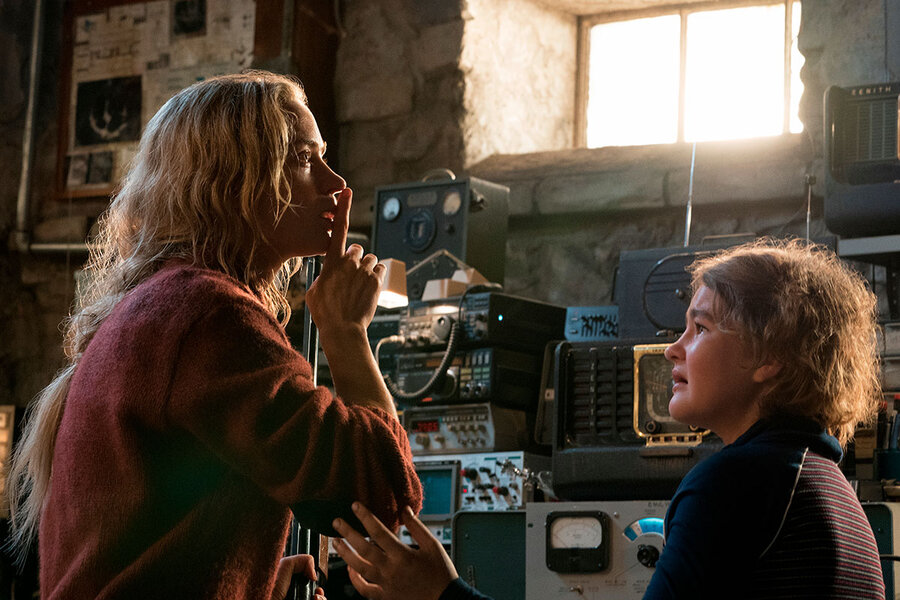‘A Quiet Place’ is about a good deal more than scaring us
Loading...
As a film critic, I am sometimes asked if there are types of movies I regularly avoid. My prepackaged answer is always “Yes. Bad movies.” But the truth is, I would just as soon skip serial killer or ninja flicks or, more to my point here, horror movies featuring gloppy, befanged alien invaders.
But what if we are talking about a great horror movie with befanged aliens? And what if the movie is about a good deal more than simply scaring us? What if it features a richly imagined family attempting to survive not only the monsters without but the demons within?
“A Quiet Place” is just such a film. At a brisk 90 minutes, it’s one of the most inventive and beautifully crafted and acted horror movies I’ve seen in a very long time, and I think the main reason for its power is the family crisis at its core. John Krasinski, who costars, directed, and co-wrote the script (with Bryan Woods and Scott Beck), understands something crucial that is lost on far too many horrormeisters: The more we care about the people in a scare picture, the scarier and more emotionally imposing it becomes.
The film’s setting is an apocalyptic near-future where the planet’s population has been decimated by ravenous crustacean-looking aliens who are sightless but possess supersensitive hearing and communicate by making dreadful clacking sounds. To quote the film’s ad line, if they hear you, they hunt you. Following a brief and wrenching preamble culminating in a family tragedy, Lee and Evelyn Abbott (Krasinski and Emily Blunt) and their two young children, Marcus (Noah Jupe) and Regan (Millicent Simmonds), have enclosed themselves in their isolated upstate New York homestead surrounded by forests and cornfields waving ominously in the wind.
They speak almost entirely in sign language (subtitles are provided) to preserve the silence and because Regan has been deaf from birth. They walk shoelessly to dampen any noise. Even their recreations are scarifying. They play Monopoly with felt tiles and roll the dice on the rug. So many movies nowadays are so assaultively loud that the near silence of “A Quiet Place,” with only the murmurous sounds of nature to intrude, is both a balm and a forewarning. The most resonant moments in the movie come when the silences are broken: When, for example, Lee ventures into the forest with his son and stands beneath a loud waterfall so their words are drowned out and the boy can briefly, joyously, shout. Or best: When Lee and Evelyn embrace in a slow, swaying dance while listening, through earpieces, to Neil Young plaintively singing “Harvest Moon.”
I’m not a fan of connecting the dots between actors’ real lives and their movie lives, but the fact that Krasinksi and Blunt are married, with two children, or that Simmonds, who also appeared in “Wonderstruck,” is actually deaf, gives the film a verity it might not normally possess. It explains, I think, the deep emotional investment on display. As effective as “A Quiet Place” is at creeping us out, there is something more powerful going on in this movie than just making us jump (which it also most certainly does).
What is at stake can be summed up when Evelyn, speaking of the perils their children face, tells her husband, “Who are we if we can’t protect them?” It’s the elemental wail of every parent afraid of what lies in wait. Lee has sealed off a basement bunker where he has been attempting to not only contact other survivors but also to construct a cochlear hearing device for Regan, which only fitfully works. Because of the tragedy that opens the movie, Regan’s connection to her father is highly fraught. One of the film’s most moving aspects is how, amid all the horror, they ache to reconcile.
We are constantly made to ask ourselves, how would we handle this situation? Because Evelyn is also pregnant, the impending birth, however carefully prepared for, cannot help but shoot a shiver through the screen. What should be a joyous event will be anything but. And yet the birth itself is a metaphor for the family’s gumption and regeneration.
I would admire “A Quiet Place” even if it were just a terrific scarefest. I enjoy boo! movies when they are as expertly made as this one is, and when they don’t pander. But what makes it a classic is that, like “Get Out,” a body-snatching movie about racism, or “The Babadook,” a supernatural horror film about childhood fears, it also works so well on so many other levels. It transcends its genre even as it fulfills it. Grade: A- (Rated PG-13 for terror and some bloody images.)







